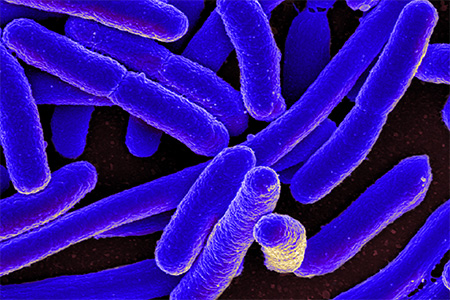Gut Microbiota
Microbiome is a hot area of research right now, but can results in mice be translated to humans? A
new paper in Disease Models & Mechanisms1 asks just that question. The authors, academic researchers at KU Leuven and Vrije Universiteit Brussel in Belgium, focused on
gut microbiome studies. They compared the similarities and differences between mice and humans and performed meta-analysis of available data on healthy gut
microbiota in the two species.
Parallels and divergences between mice and humans

The authors caution researchers from assuming direct parallels between mice and humans based on some of the anatomical divergences between them. Comparison of multiple datasets showed differences between the healthy gut microbiome in humans and mice. While some genera have similar relative abundance, others are much more abundant in one organism or the other. The authors noted core gut microbiota (gut organisms always present across samples) seems to be smaller in mice than humans based on the limited data that currently exists. However, the total number of genera found in mice according to the available data is higher than in humans. An important outcome of the analysis was that there simply isn’t enough data to conclude the similarities and differences between mouse and human microbiota.
Microbiome and disease
Both mice and humans show shifts in relative abundance of particular organisms in their gut based on diet, although enterotypes seem to shift based on diet changes more quickly in mice compared to humans. Although mouse models do not fully recapitulate human IBD, similar microbiota shifts as in humans have been seen in mouse colitis models.
Care and housing of microbiome study animals
The authors included some practical analysis of relevant experimental factors for microbiome studies. Housing factors such as an SPF mouse house as well co-housing versus single housing affect mouse gut microbiota. Diet is another factor to carefully assess, as it clearly can affect the outcome of microbiome studies. As with all types of studies, genetics have a big effect, and results can vary from mouse strain to strain.
Role for rats?
While much of the existing research has taken place in mice, investigators are not ignoring other animal models. Association of germ-free rats with human microbiota may prove to be a more representative model compared to similar studies starting with
germ-free mice. Other models studied to date include guinea pigs, dogs, pigs and non-human primates.
 View the Taconic Biosciences' Webinar:
View the Taconic Biosciences' Webinar:
Reference:
1. Nguyen TL, Vieira-Silva S, Liston A, Raes J. (2015) How informative is the mouse for human gut microbiota research? Dis Model Mech. 8(1):1-16.
 The authors caution researchers from assuming direct parallels between mice and humans based on some of the anatomical divergences between them. Comparison of multiple datasets showed differences between the healthy gut microbiome in humans and mice. While some genera have similar relative abundance, others are much more abundant in one organism or the other. The authors noted core gut microbiota (gut organisms always present across samples) seems to be smaller in mice than humans based on the limited data that currently exists. However, the total number of genera found in mice according to the available data is higher than in humans. An important outcome of the analysis was that there simply isn’t enough data to conclude the similarities and differences between mouse and human microbiota.
The authors caution researchers from assuming direct parallels between mice and humans based on some of the anatomical divergences between them. Comparison of multiple datasets showed differences between the healthy gut microbiome in humans and mice. While some genera have similar relative abundance, others are much more abundant in one organism or the other. The authors noted core gut microbiota (gut organisms always present across samples) seems to be smaller in mice than humans based on the limited data that currently exists. However, the total number of genera found in mice according to the available data is higher than in humans. An important outcome of the analysis was that there simply isn’t enough data to conclude the similarities and differences between mouse and human microbiota.















.jpg)

.jpg)
.jpg)
.jpg)
.jpg)





.jpg)


.jpg)
.jpg)

.jpg)


.jpg)





.jpg)

.jpg)




